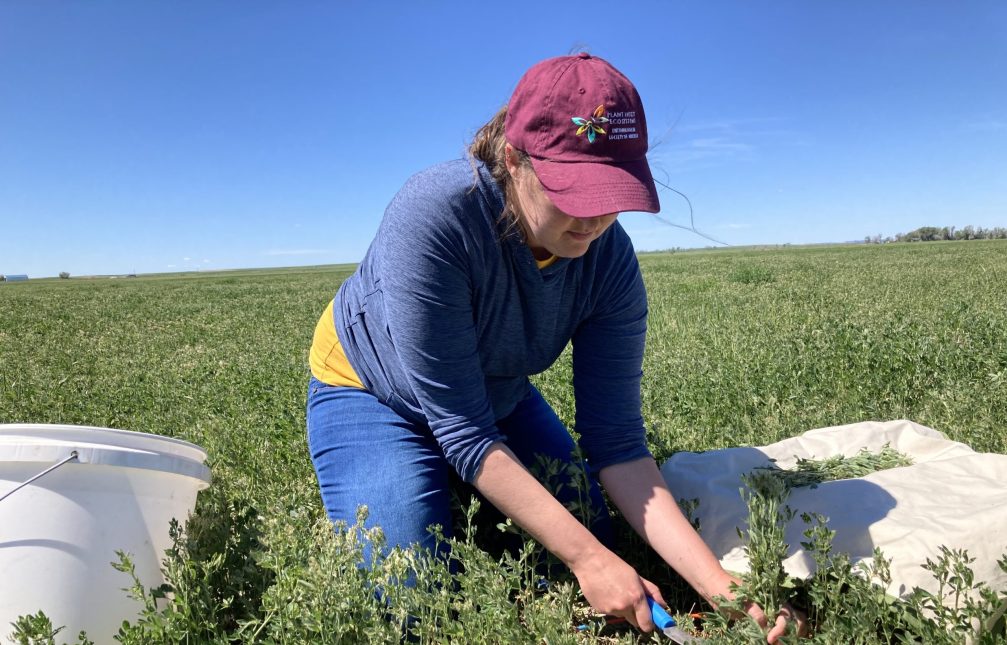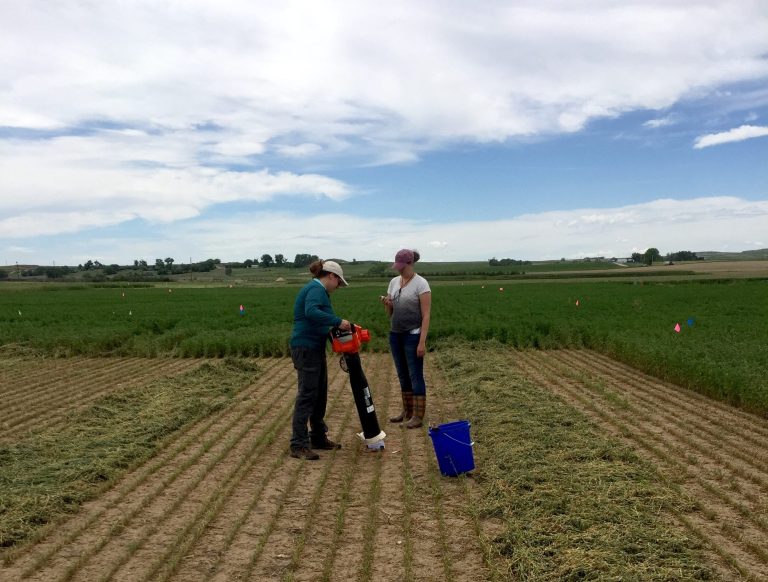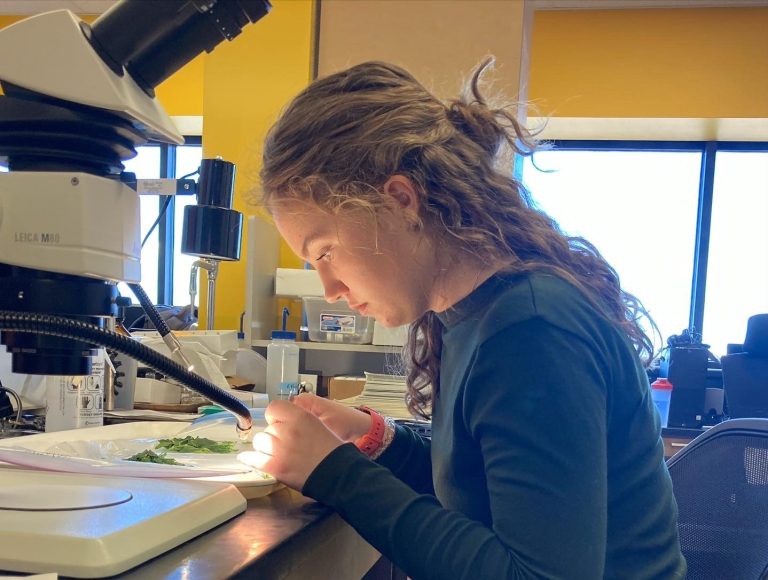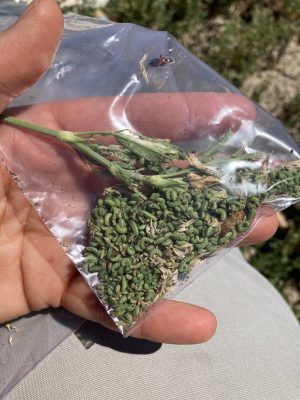
Early harvest is often touted as an effective solution to Wyoming’s weevil problem. But recommendations are usually vague at best, lacking specificity and rigorous scientific testing.
“Oftentimes producers have been told to cut early to decrease alfalfa weevil, but there’s not a lot of work backing up why cutting early is good or how early you should be cutting,” says Judith Herreid, a Ph.D. student in the UW Department of Plant Sciences.
To develop more specific, evidence-based suggestions, Herreid and UW associate professor Randa Jabbour set out to quantify how harvest timing and insecticide use affects harvest quality, yield, and alfalfa weevil density.
In a two-year study¹ conducted at the James C. Hageman Sustainable Agriculture Research and Extension Center (SAREC) near Lingle, Herreid and Jabbour compared three harvest timings differentiated by growth stage: early bud, late bud, and bloom. Half of each research plot was treated with insecticide, allowing the researchers to test how insecticide application influenced outcomes relative to harvest timing.
Weevil density was recorded immediately before and after harvest. Herreid also worked with forage agronomist Anowar Islam to analyze forage quality and determine relative feed value, metrics that were used to compare the economic impacts of different treatments.
Challenging the 20 percent bloom rule
As predicted, early harvest resulted in higher quality forage and later harvest resulted in higher yield. The difference in quality was more dramatic than the difference in yield, Herreid notes. She and Jabbour did not observe any differences in yield or quality in later cuttings of plots that were initially harvested early.
Their results suggest that early harvest is the most effective way to prevent weevil damage. While harvesting at 20 percent bloom is common practice, “Our work shows that if you’re really worried about alfalfa weevil, you should not wait that long,” Jabbour says. “We have strong evidence to support that this is an effective method if it fits in with someone’s operation.”
The early harvest approach might not work for everyone, she acknowledges. For producers growing high-quality hay to sell to dairies, harvesting early might be the obvious choice. But for someone growing alfalfa to feed their own beef cattle, getting the highest possible yield is likely of more concern than quality. Not to mention, what if the weather conditions are terrible and logistics don’t go according to plan?
“I think that’s the trickiest part of this—you have to have so many other things fall into place to be able to do it,” she comments.


Are insecticides worth it?
It depends.
If you’re planning to cut early anyway, Herreid and Jabbour’s research suggests you might as well save some time, labor, and money by skipping insecticide application altogether.
In crops harvested later, insecticide use did appear to reduce alfalfa weevil damage. “But compared to just cutting early, it definitely didn’t look like insecticide use was a better method. You still had damage on your alfalfa. If you cut later, your quality still went down—insecticide use doesn’t impact that at all,” Herreid notes.
If a producer plans to cut late and it’s a bad year for weevils, insecticide application may be worthwhile. But for those planning on an early harvest, insecticide use is likely of little benefit. Paired with the looming issue of insecticide resistance, this finding makes a strong case for harvesting early and forgoing insecticide use.
Rethinking the insurance approach
Insecticides provide an insurance policy—for now. As insecticide resistance spreads across the West, alfalfa producers may have to consider other options.
“Unfortunately, it’s an insurance approach that will ultimately lead to more resistance, faster development of resistance, and killing a bunch of beneficial insects,” says Jabbour.
To help prevent resistance, she recommends harvesting early without applying insecticides when possible. “If you have a year that’s lower pressure and you can do early harvest instead, then that’s definitely going to help maintain susceptibility in that population,” she notes. “The more frequently people are spraying the same area, the faster the rates of development—anything that helps preserve that susceptibility, either in space or time, is good.”
Maintaining susceptibility is also important from an economic perspective: alternatives to widely used insecticides are often more expensive and less effective.
What about my bottom line?
Using Herreid’s forage quality results and data from the USDA Agricultural Marketing Service, UW economists Brian Lee and John Ritten analyzed the economic consequences of harvest timing and insecticide use.

In 2019, a water-limited year, different treatments resulted in minimal changes in revenue. Ritten suggests that under such conditions, it may be best to forgo insecticide use and rely on early harvest if weevil infestations are a concern.
In 2021, the second year of the study, Ritten and Lee found that on average, across all harvest timings, crops treated with insecticides resulted in slightly higher revenues. This was likely because insecticide usage increased yield in middle harvest timing and/or increased quality in late harvest timing. However, increases in revenue were approximately equal to the estimated cost of insecticide.
Overall, revenue was affected more by harvest timing than insecticide use. Even though quality decreased somewhat with later harvest timings, the increase in quantity tended to more than offset the decrease in quality.
The economists predict that, in the near term, insecticide resistance will eliminate the slight revenue boost associated with insecticide application.
“In Wyoming, alfalfa is the most economically valuable crop we have,” says Herreid. “Finding different ways of controlling alfalfa weevil, especially through non-chemical methods, is important, especially now that insecticide resistance is becoming a problem in our state.”
Considering early harvest might be a good place to start.




